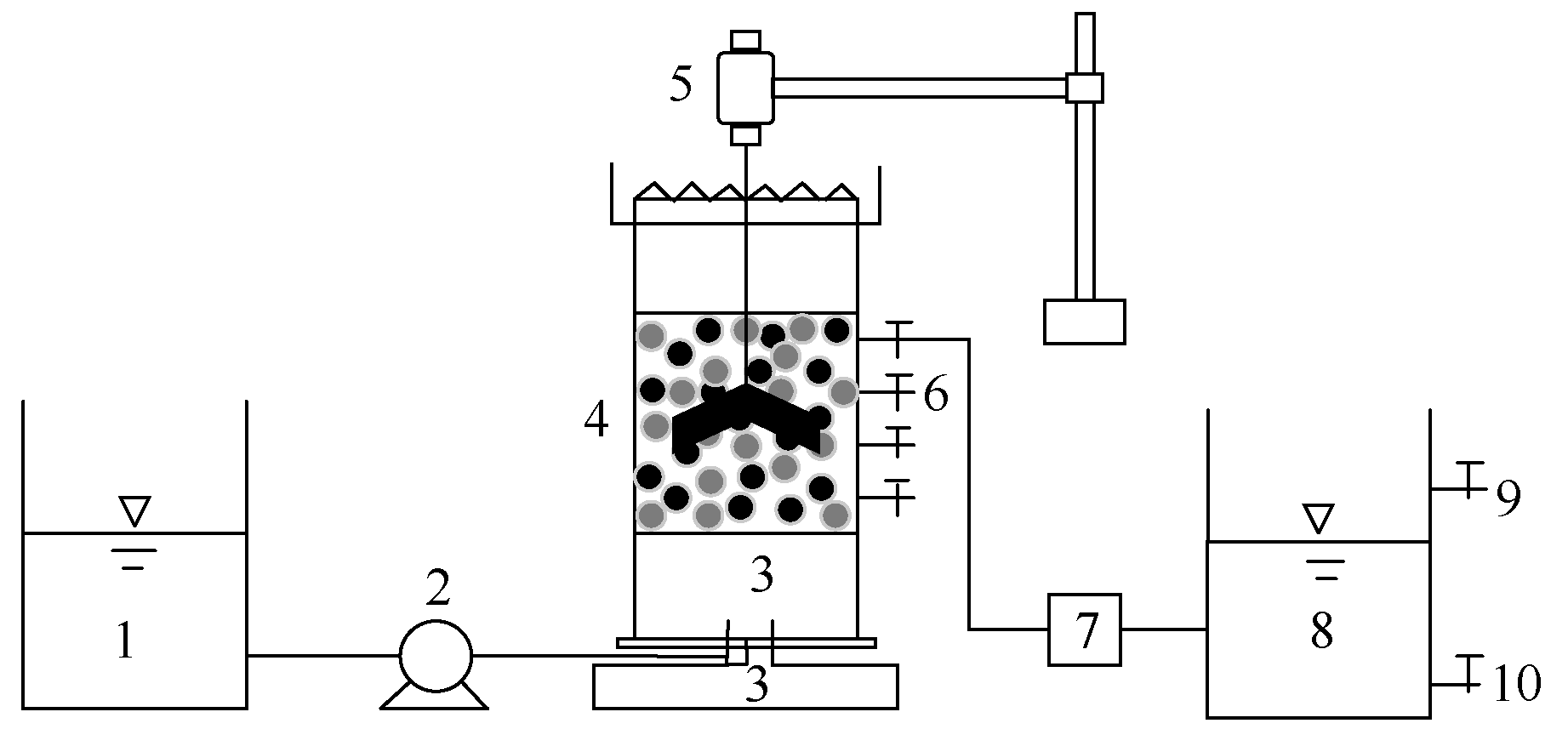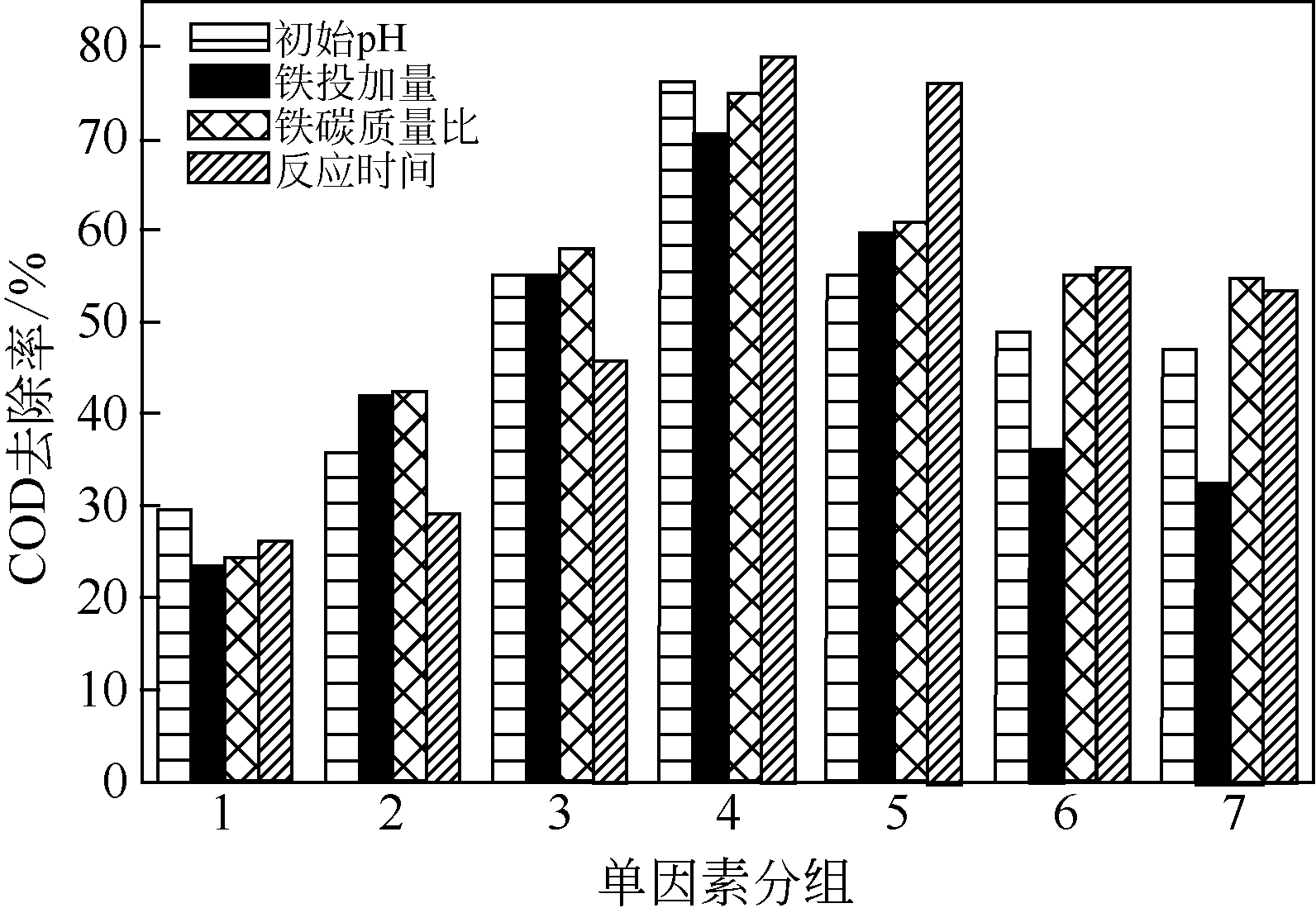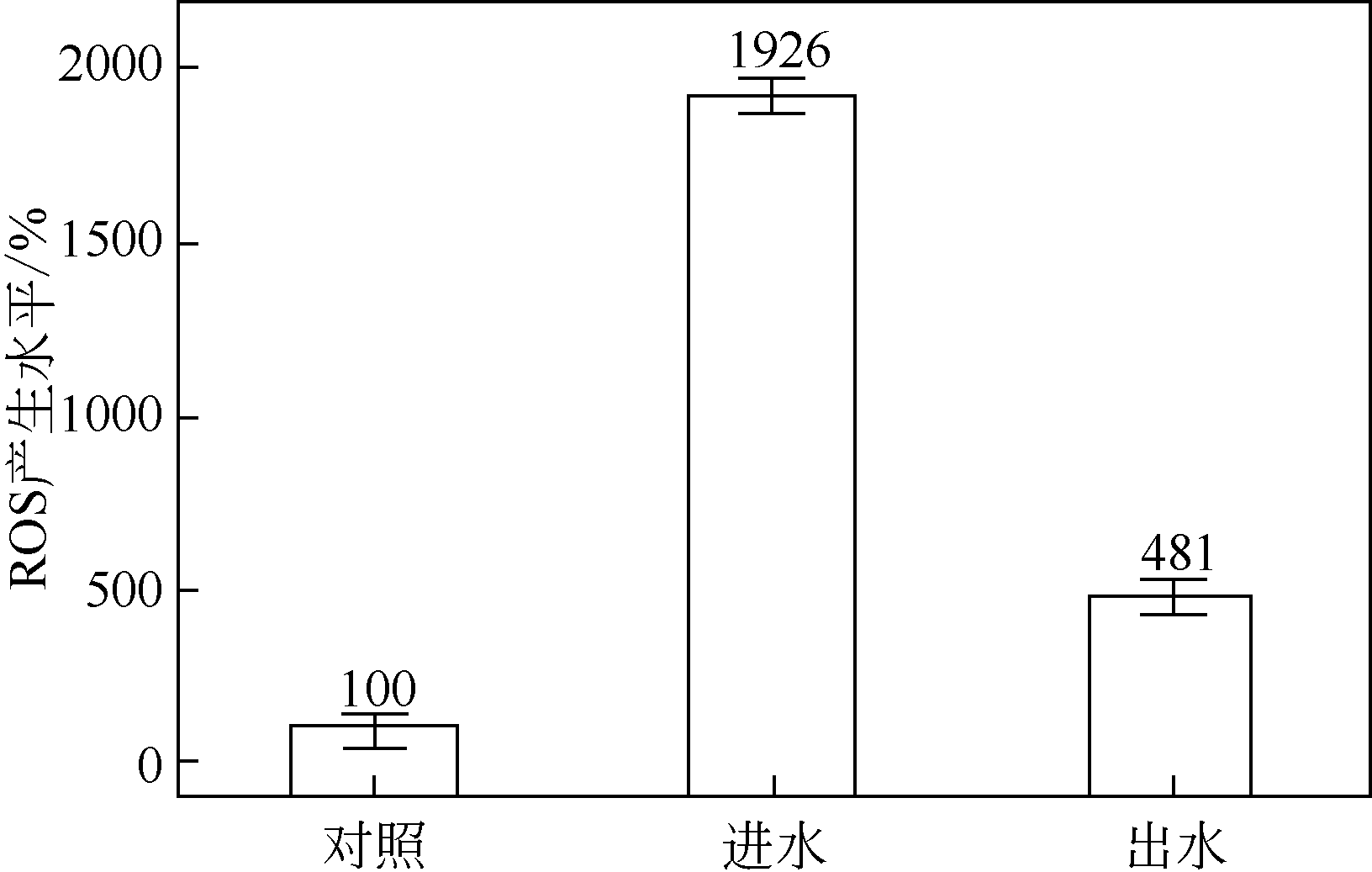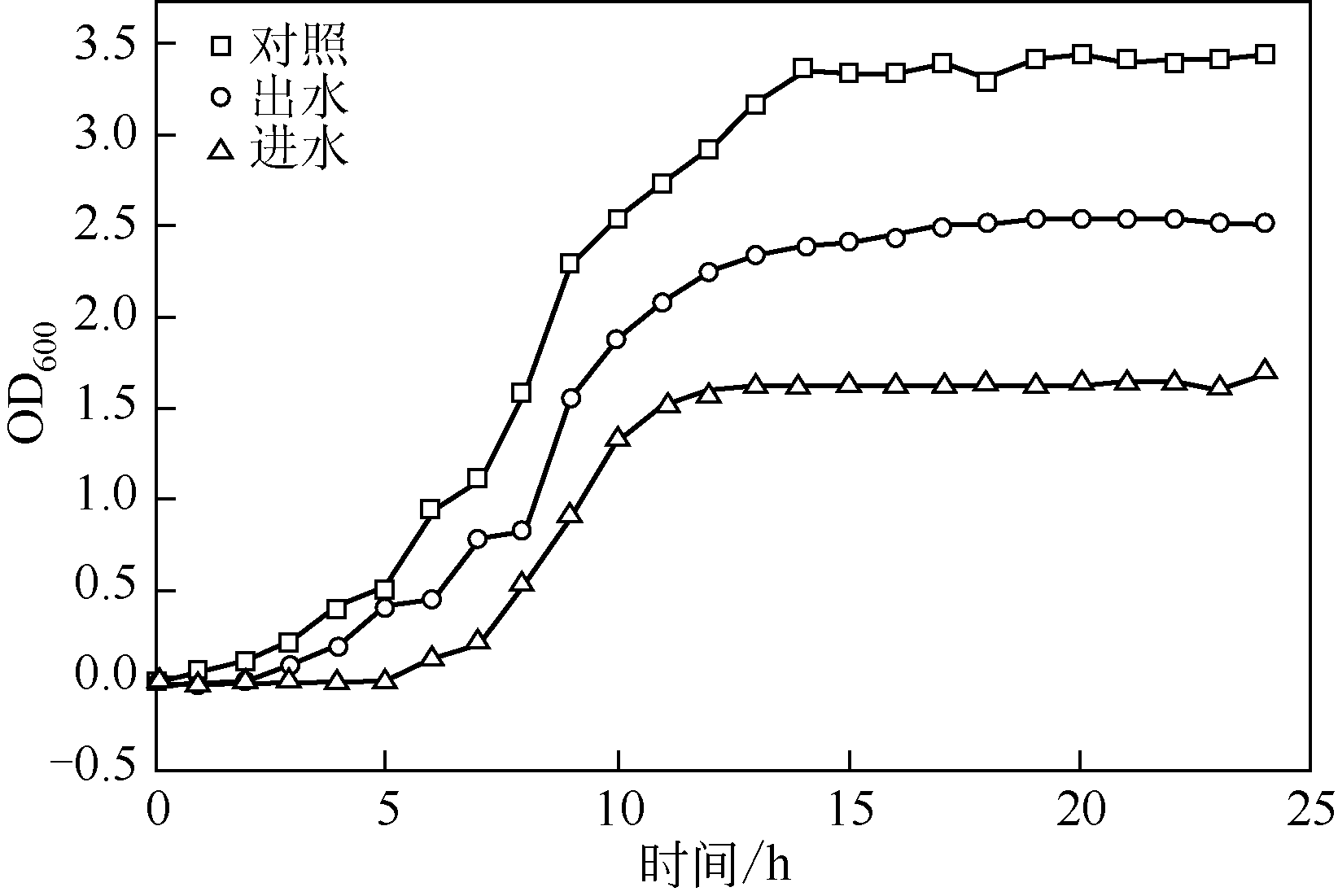化工进展 ›› 2020, Vol. 39 ›› Issue (2): 790-797.DOI: 10.16085/j.issn.1000-6613.2019-0797
铁碳微电解处理印染废水的效能及生物毒性变化
- 东北电力大学化学工程学院,吉林 吉林 132012
-
收稿日期:2019-05-16出版日期:2020-02-05发布日期:2020-03-12 -
通讯作者:张兰河 -
作者简介:贾艳萍(1973—),女,博士,教授,研究方向为废水处理理论与工艺。E-mail:jiayanping1111@sina.com 。 -
基金资助:国家自然科学基金(51678119);吉林省科技厅科技发展计划(20180201016SF);吉林省教育厅“十三五”科学技术研究项目(JJKH20180454KJ)
Efficiency and biological toxicity of iron-carbon microelectrolysis in treatment of the dye wastewater
Yanping JIA( ),Zhen ZHANG,Zhenhao BI,Jian ZHANG,Lanhe ZHANG(
),Zhen ZHANG,Zhenhao BI,Jian ZHANG,Lanhe ZHANG( )
)
- School of Chemical Engineering, Northeast Electric Power University, Jilin 132012, Jilin, China
-
Received:2019-05-16Online:2020-02-05Published:2020-03-12 -
Contact:Lanhe ZHANG
摘要:
为了提高铁碳微电解工艺处理实际印染废水的效率,采用响应面法进行工艺条件优化。以COD去除率为响应值,初始pH、铁投加量、铁碳质量比及反应时间为实验因素,构建响应面模型,分析模型的显著性。结果表明:当初始pH为3.53、铁投加量为83.92g/L、铁碳质量比为0.82及反应时间为78.48min时,COD去除率的预测值为75.25%,与实测值相差0.23%(<2%),可以利用该模型预测COD去除率的变化。同时采用大肠杆菌对铁碳微电解工艺进出水的生物毒性进行检测,与进水组相比,出水组中乳酸脱氢酶(LDH)释放量由对照组的2.13倍下降至对照组的1.64倍,同时活性氧物质(ROS)产生水平由对照组的19.26倍下降至对照组的4.81倍,细胞死亡率由98.1%下降至61.5%,对数期由5h延长至9h,且BOD5/COD从0.151升至0.416,因此铁碳微电解工艺具有降低印染废水生物毒性的作用。
中图分类号:
引用本文
贾艳萍,张真,毕朕豪,张健,张兰河. 铁碳微电解处理印染废水的效能及生物毒性变化[J]. 化工进展, 2020, 39(2): 790-797.
Yanping JIA,Zhen ZHANG,Zhenhao BI,Jian ZHANG,Lanhe ZHANG. Efficiency and biological toxicity of iron-carbon microelectrolysis in treatment of the dye wastewater[J]. Chemical Industry and Engineering Progress, 2020, 39(2): 790-797.
| 水质 | 颜色 | COD/mg·L-1 | TOC | 浊度/NTU | 色度/倍 | BOD5/COD | pH | 味道 | |
|---|---|---|---|---|---|---|---|---|---|
| 印染废水 | 鲜红色 | 1288±100 | 107.8±10 | 10.9±4 | 112.4±3.2 | 345.2±15 | 0.151 | 4.58±1 | 刺激性酸臭味 |
表1 实际印染废水水质指标
| 水质 | 颜色 | COD/mg·L-1 | TOC | 浊度/NTU | 色度/倍 | BOD5/COD | pH | 味道 | |
|---|---|---|---|---|---|---|---|---|---|
| 印染废水 | 鲜红色 | 1288±100 | 107.8±10 | 10.9±4 | 112.4±3.2 | 345.2±15 | 0.151 | 4.58±1 | 刺激性酸臭味 |
| 编码 | 因素 | 水平 | ||
|---|---|---|---|---|
| -1 | 0 | 1 | ||
| A | 初始pH | 2 | 4 | 6 |
| B | 铁投加量/g·L-1 | 60 | 80 | 100 |
| C | 铁碳质量比 | 0.6 | 0.8 | 1 |
| D | 反应时间/min | 60 | 90 | 120 |
表2 响应面实验因素及水平设计表
| 编码 | 因素 | 水平 | ||
|---|---|---|---|---|
| -1 | 0 | 1 | ||
| A | 初始pH | 2 | 4 | 6 |
| B | 铁投加量/g·L-1 | 60 | 80 | 100 |
| C | 铁碳质量比 | 0.6 | 0.8 | 1 |
| D | 反应时间/min | 60 | 90 | 120 |
| 序号 | 变量取值 | COD去除率/% | |||
|---|---|---|---|---|---|
| A | B | C | D | ||
| 1 | -1 | 1 | 0 | 0 | 69.83 |
| 2 | 0 | 1 | 0 | 1 | 62.27 |
| 3 | 0 | 0 | 0 | 0 | 75.28 |
| 4 | 0 | 0 | -1 | 1 | 68.28 |
| 5 | -1 | 0 | -1 | 0 | 71.91 |
| 6 | 0 | 1 | -1 | 0 | 69.70 |
| 7 | 1 | 0 | -1 | 0 | 67.29 |
| 8 | 0 | -1 | 0 | -1 | 66.49 |
| 9 | 0 | 0 | 0 | 0 | 75.35 |
| 10 | 1 | -1 | 0 | 0 | 67.60 |
| 11 | 1 | 0 | 1 | 0 | 69.97 |
| 12 | 0 | 0 | -1 | -1 | 70.20 |
| 13 | 1 | 1 | 0 | 0 | 66.51 |
| 14 | 0 | 0 | 1 | -1 | 73.37 |
| 15 | 1 | 0 | 0 | 1 | 66.61 |
| 16 | -1 | 0 | 1 | 0 | 71.05 |
| 17 | -1 | 0 | 0 | 1 | 68.91 |
| 18 | 0 | 0 | 0 | 0 | 74.40 |
| 19 | 1 | 0 | 0 | -1 | 68.65 |
| 20 | 0 | -1 | -1 | 0 | 66.25 |
| 21 | 0 | 1 | 0 | -1 | 71.93 |
| 22 | 0 | 1 | 1 | 0 | 68.55 |
| 23 | -1 | -1 | 0 | 0 | 65.96 |
| 24 | 0 | 0 | 0 | 0 | 74.68 |
| 25 | -1 | 0 | 0 | -1 | 72.05 |
| 26 | 0 | 0 | 1 | 1 | 70.55 |
| 27 | 0 | 0 | 0 | 0 | 73.98 |
| 28 | 0 | -1 | 0 | 1 | 65.96 |
| 29 | 0 | -1 | 1 | 0 | 68.21 |
表3 响应面实验组次设计结果
| 序号 | 变量取值 | COD去除率/% | |||
|---|---|---|---|---|---|
| A | B | C | D | ||
| 1 | -1 | 1 | 0 | 0 | 69.83 |
| 2 | 0 | 1 | 0 | 1 | 62.27 |
| 3 | 0 | 0 | 0 | 0 | 75.28 |
| 4 | 0 | 0 | -1 | 1 | 68.28 |
| 5 | -1 | 0 | -1 | 0 | 71.91 |
| 6 | 0 | 1 | -1 | 0 | 69.70 |
| 7 | 1 | 0 | -1 | 0 | 67.29 |
| 8 | 0 | -1 | 0 | -1 | 66.49 |
| 9 | 0 | 0 | 0 | 0 | 75.35 |
| 10 | 1 | -1 | 0 | 0 | 67.60 |
| 11 | 1 | 0 | 1 | 0 | 69.97 |
| 12 | 0 | 0 | -1 | -1 | 70.20 |
| 13 | 1 | 1 | 0 | 0 | 66.51 |
| 14 | 0 | 0 | 1 | -1 | 73.37 |
| 15 | 1 | 0 | 0 | 1 | 66.61 |
| 16 | -1 | 0 | 1 | 0 | 71.05 |
| 17 | -1 | 0 | 0 | 1 | 68.91 |
| 18 | 0 | 0 | 0 | 0 | 74.40 |
| 19 | 1 | 0 | 0 | -1 | 68.65 |
| 20 | 0 | -1 | -1 | 0 | 66.25 |
| 21 | 0 | 1 | 0 | -1 | 71.93 |
| 22 | 0 | 1 | 1 | 0 | 68.55 |
| 23 | -1 | -1 | 0 | 0 | 65.96 |
| 24 | 0 | 0 | 0 | 0 | 74.68 |
| 25 | -1 | 0 | 0 | -1 | 72.05 |
| 26 | 0 | 0 | 1 | 1 | 70.55 |
| 27 | 0 | 0 | 0 | 0 | 73.98 |
| 28 | 0 | -1 | 0 | 1 | 65.96 |
| 29 | 0 | -1 | 1 | 0 | 68.21 |
| 变差来源 | 平方和 | 自由度 | 均方和 | F | P | 显著性 |
|---|---|---|---|---|---|---|
| 模型 | 280.22 | 14 | 20.02 | 19.12 | <0.0001 | 极显著 |
| A | 14.26 | 1 | 14.26 | 13.62 | 0.0024 | 极显著 |
| B | 5.77 | 1 | 5.77 | 5.51 | 0.0341 | 显著 |
| C | 3.07 | 1 | 3.07 | 2.93 | 0.1088 | 不显著 |
| D | 27.33 | 1 | 27.33 | 26.11 | 0.0002 | 极显著 |
| AB | 6.15 | 1 | 6.15 | 5.88 | 0.0295 | 显著 |
| AC | 3.13 | 1 | 3.13 | 2.99 | 0.1056 | 不显著 |
| AD | 0.30 | 1 | 0.30 | 0.29 | 0.5993 | 不显著 |
| BC | 4.22 | 1 | 4.22 | 4.03 | 0.0643 | 不显著 |
| BD | 25.65 | 1 | 25.65 | 24.51 | 0.0002 | 极显著 |
| CD | 0.90 | 1 | 0.90 | 0.86 | 0.3689 | 不显著 |
| A2 | 53.52 | 1 | 53.52 | 51.12 | <0.0001 | 极显著 |
| B2 | 146.80 | 1 | 146.80 | 140.23 | <0.0001 | 极显著 |
| C2 | 14.57 | 1 | 14.57 | 13.92 | 0.0022 | 极显著 |
| D2 | 49.27 | 1 | 49.27 | 47.07 | <0.0001 | 极显著 |
| 残差 | 14.66 | 14 | 1.05 | |||
| 失拟项 | 13.30 | 10 | 1.33 | 3.91 | 0.1004 | 不显著 |
| 误差 | 1.36 | 4 | 0.34 | |||
| 合计 | 294.88 | 28 | ||||
| 标准偏差(Std. Dev.) | 1.02 | 相关系数(R-Squared) | 0.9503 | |||
| 平均值(Mean) | 69.82 | 校正决定系数 (Adj R-Squared) | 0.9006 | |||
| 变异系数(C.V. %) | 1.47 | 预测相关系数 (Pred R-Squared) | 0.7331 | |||
| 压力系数(PRESS) | 78.71 | 信噪比(Adeq Precision) | 14.761 | |||
表4 COD去除率(响应值Y)模型方差分析
| 变差来源 | 平方和 | 自由度 | 均方和 | F | P | 显著性 |
|---|---|---|---|---|---|---|
| 模型 | 280.22 | 14 | 20.02 | 19.12 | <0.0001 | 极显著 |
| A | 14.26 | 1 | 14.26 | 13.62 | 0.0024 | 极显著 |
| B | 5.77 | 1 | 5.77 | 5.51 | 0.0341 | 显著 |
| C | 3.07 | 1 | 3.07 | 2.93 | 0.1088 | 不显著 |
| D | 27.33 | 1 | 27.33 | 26.11 | 0.0002 | 极显著 |
| AB | 6.15 | 1 | 6.15 | 5.88 | 0.0295 | 显著 |
| AC | 3.13 | 1 | 3.13 | 2.99 | 0.1056 | 不显著 |
| AD | 0.30 | 1 | 0.30 | 0.29 | 0.5993 | 不显著 |
| BC | 4.22 | 1 | 4.22 | 4.03 | 0.0643 | 不显著 |
| BD | 25.65 | 1 | 25.65 | 24.51 | 0.0002 | 极显著 |
| CD | 0.90 | 1 | 0.90 | 0.86 | 0.3689 | 不显著 |
| A2 | 53.52 | 1 | 53.52 | 51.12 | <0.0001 | 极显著 |
| B2 | 146.80 | 1 | 146.80 | 140.23 | <0.0001 | 极显著 |
| C2 | 14.57 | 1 | 14.57 | 13.92 | 0.0022 | 极显著 |
| D2 | 49.27 | 1 | 49.27 | 47.07 | <0.0001 | 极显著 |
| 残差 | 14.66 | 14 | 1.05 | |||
| 失拟项 | 13.30 | 10 | 1.33 | 3.91 | 0.1004 | 不显著 |
| 误差 | 1.36 | 4 | 0.34 | |||
| 合计 | 294.88 | 28 | ||||
| 标准偏差(Std. Dev.) | 1.02 | 相关系数(R-Squared) | 0.9503 | |||
| 平均值(Mean) | 69.82 | 校正决定系数 (Adj R-Squared) | 0.9006 | |||
| 变异系数(C.V. %) | 1.47 | 预测相关系数 (Pred R-Squared) | 0.7331 | |||
| 压力系数(PRESS) | 78.71 | 信噪比(Adeq Precision) | 14.761 | |||
| 1 | FATEMEH S F, CAVUS F. Zero valent nano-sized iron/clinoptilolite modified with zero valent copper for reductive nitrate removal[J]. Process Safety and Environmental Protection, 2013, 91(4): 304-310. |
| 2 | SAMARGHANDI M R, ZARRABI M, AMRANE A, et al. Kinetic of degradation of two azo dyes from aqueous solutions by zero iron powder: determination of the optimal conditions[J]. Desalination and Water Treatment, 2012, 40(1/2/3): 137-143. |
| 3 | ZHU X Y, CHEN X J, YANG Z M, et al. Investigating the influences of electrode material property on degradation behavior of organic wastewaters by iron-carbon micro-electrolysis[J]. Chemical Engineering Journal, 2018, 338(15): 46-54. |
| 4 | CHE J G, WAN J B, HUANG X P, et al. Pretreatment of piggery digestate wastewater by ferric-carbon micro-electrolysis under alkalescence condition[J]. Korean Journal of Chemical Engineering, 2017, 34(9): 1-9. |
| 5 | 卢亮, 陈军昊, 王树荣. 模拟生物油分子蒸馏的响应面法工况优化[J]. 化工进展, 2018, 37(7): 2605-2612. |
| LU L, CHEN J H, WANG S R. Condition optimization of simulated bio-oil molecular distillation via response surface method[J]. Chemical Industry and Engineering Progress, 2018, 37(7): 2605-2612. | |
| 6 | 李亿, 张红岩, 朱婧, 等. 响应面优化木糖母液发酵产丁二酸[J]. 化工进展, 2018, 37(1): 252-259. |
| LI Y, ZHANG H Y, ZHU J, et al. Optimization of succinic acid fermentation from xylose mother liquor by response surface methodology[J]. Chemical Industry and Engineering Progress, 2018, 37(1): 252-259. | |
| 7 | 王哲, 张思思, 黄国和, 等. 高炉水淬渣对电镀废水中重金属和COD吸附的响应面优化[J]. 化工进展, 2016, 35(11): 3669-3676. |
| WANG Z, ZHANG S S, HUANG G H, et al. Application of response surface methodology to optimize adsorption conditions for heavy metals and COD in electroplating waste water by water-quenched blast furnace slag[J]. Chemical Industry and Engineering Progress, 2016, 35(11): 3669-3676. | |
| 8 | 张东升, 余丽胜, 焦纬洲, 等. 基于响应面法的超声强化铁碳微电解处理硝基苯废水工艺优化研究[J]. 含能材料, 2018, 26(2): 178-184. |
| ZHANG D S, YU L S, JIAO W Z, et al. Treatment of nitrobenzene wastewater via ultrasonic enhanced iron-carbon micro-electrolysis with response surface methodology[J]. Chinese Journal of Energetic Materials, 2018, 26(2): 178-184. | |
| 9 | 余若祯, 穆玉峰, 王海燕, 等. 排水综合评价中的生物毒性测试技术[J]. 环境科学研究, 2014, 27(4): 390-397. |
| YU R Z, MU Y F, WANG H Y, et al. Review on the aquatic organisms toxicity test in the whole effluent assessment[J]. Research of Environmental Sciences, 2014, 27(4): 390-397. | |
| 10 | 戴迪楠. 基于生物毒性检测的污水水质安全评价及污水深度处理生物毒性削减特性的研究[D]. 西安: 西安建筑科技大学, 2017. |
| DAI D N. A toxicity-based method for water safety assessment and biological toxicity reduction characteristics of deep treatment[D]. Xi’an: Xi’an University of Architecture and Technology, 2017. | |
| 11 | 何勤聪, 成国飞, 任源, 等. 精细化工废水有机成分分析及其生物降解性与毒性的拓扑研究[J]. 化工进展, 2009, 28(6): 1080-1085. |
| HE Q C, CHENG G F, REN Y, et al. Organic compounds in fine chemical wastewater, their composition analysis and topological study in biodegradability and toxicity[J]. Chemical Industry and Engineering Progress, 2009, 28(6): 1080-1085. | |
| 12 | 王学江, 王虹, 赵建夫, 等. 基于大肠杆菌的CellSense生物传感器毒性分析性能研究[J]. 环境科学, 2009, 30(4): 1210-1214. |
| WANG X J, WANG H, ZHAO J F, et al. Acute toxicity analysis performance of CellSense biosensor with E. coli[J]. Environmental Science, 2009, 30(4): 1210-1214. | |
| 13 | 钱俊, 李久铭, 只金芳, 等. 基于大肠杆菌的全细胞微生物传感器的构建及其在急性生物毒性检测中的应用[J]. 分析化学, 2013, 41(5): 738-743. |
| QIAN J, LI J M, ZHI J F, et al. Development of a whole cells microbial biosensor based on E. coli and its application to acute biotoxicity determination[J]. Chinese Journal of Analytical Chemistry, 2013, 41(5): 738-743. | |
| 14 | 曹强, 签孝琳, 张澍, 等. 大气细颗粒物水溶成分和非水溶成分的细胞毒性[J]. 环境科学学报, 2008, 28(6): 1167-1172. |
| CAO Q, QIAN X L, ZHANG S, et al. Cytotoxicity of soluble and insoluble components of atmospheric fine particles[J]. Acta Soientiae Circumstantiae, 2008, 28(6): 1167-1172. | |
| 15 | MIRJANA B, VESNA M, NATAŠA S, et al. In vitro evaluation of neurotoxicity potential and oxidative stress responses of diazinon and its degradation products in rat brain synaptosomes[J]. Toxicology Letters, 2015, 233(1): 29-37. |
| 16 | 胡立新. 基于傅里叶变换红外光谱的生物毒性测试方法及咪唑类离子液体毒性作用机制研究[D]. 北京: 中国科学院大学, 2018. |
| HU L X. Preliminary investigation into biological toxicity based on FTIR and the toxic mechanism of imidazolium based ionic liquids[D]. Beijing: University of Chinese Academy of Sciences, 2018. | |
| 17 | 李媛媛. 反应型活性氧荧光探针的构建及其在环境水样和生物体中的应用[D]. 镇江: 江苏大学, 2017. |
| LI Y Y. Construction of reaction-based fluorescent probes for reactive oxygen species of water samples and living organisms[D]. Zhenjiang: Jiangsu University, 2017. | |
| 18 | 张鑫, 王旗. 细胞中活性氧的荧光探针检测法研究进展[J]. 现代预防医学, 2010, 37(22): 4316-4318. |
| ZHANG X, WANG Q. Progress in measurement of reactive oxygen species in cells by using fluorescent probes[J]. Modern Preventive Medicine, 2010, 37(22): 4316-4318. | |
| 19 | CABISCOL E, TAMARIT J, ROS J. Oxidative stress in bacteria and protein damage by reactive oxygen species[J]. International Microbiology, 2000, 3(1): 3-8. |
| 20 | 石柳. 焦化废水及氧化石墨烯对水生生物的毒性研究[D]. 大连: 大连理工大学, 2017. |
| SHI L. Toxicity of coking wastewater and graphene oxide on aquatic organisms[D]. Dalian: Dalian University of Technology, 2017. | |
| 21 | 王学, 李勇超, 李铁龙, 等. 零价纳米铁对大肠杆菌的毒性效应[J]. 生态毒理学报, 2012, 7(1): 49-56. |
| WANG X, LI Y C, LI T L, et al. Toxicity effects of nano-Fe0 on Escherichia coli[J]. Asian Journal of Ecotoxicology, 2012, 7(1): 49-56. | |
| 22 | KEENAN C R, SEDLAK D L. Factors affecting the yield of oxidants from the reaction of nanoparticulate zero-valent iron and oxygen[J]. Environmental Science and Technology, 2008, 42(4): 1262-1267. |
| 23 | 王静, 王晓燕, 水中和, 等. 玻璃载银抗菌材料的Ag+溶出性质及与大肠杆菌作用机理[J]. 材料导报, 2018, 32(16): 2709-2714, 2727. |
| WANG J, WANG X Y, SHUI Z H, et al. Properties of silver ions release and antibacterial mechanism against E. coli of Ag-doped glass antimicrobial material[J]. Materials Reports, 2018, 32(16): 2709-2714, 2727. |
| [1] | 许春树, 姚庆达, 梁永贤, 周华龙. 共价有机框架材料功能化策略及其对Hg(Ⅱ)和Cr(Ⅵ)的吸附性能研究进展[J]. 化工进展, 2023, 42(S1): 461-478. |
| [2] | 赵景超, 谭明. 表面活性剂对电渗析减量化工业含盐废水的影响[J]. 化工进展, 2023, 42(S1): 529-535. |
| [3] | 孙玉玉, 蔡鑫磊, 汤吉海, 黄晶晶, 黄益平, 刘杰. 反应精馏合成甲基丙烯酸甲酯工艺优化及节能[J]. 化工进展, 2023, 42(S1): 56-63. |
| [4] | 徐晨阳, 都健, 张磊. 基于图神经网络的化学反应优劣评价[J]. 化工进展, 2023, 42(S1): 205-212. |
| [5] | 陈匡胤, 李蕊兰, 童杨, 沈建华. 质子交换膜燃料电池气体扩散层结构与设计研究进展[J]. 化工进展, 2023, 42(S1): 246-259. |
| [6] | 陈林, 徐培渊, 张晓慧, 陈杰, 徐振军, 陈嘉祥, 密晓光, 冯永昌, 梅德清. 液化天然气绕管式换热器壳侧混合工质流动及传热特性[J]. 化工进展, 2023, 42(9): 4496-4503. |
| [7] | 刘炫麟, 王驿凯, 戴苏洲, 殷勇高. 热泵中氨基甲酸铵分解反应特性及反应器结构优化[J]. 化工进展, 2023, 42(9): 4522-4530. |
| [8] | 张帆, 陶少辉, 陈玉石, 项曙光. 基于改进恒热传输模型的精馏模拟初始化[J]. 化工进展, 2023, 42(9): 4550-4558. |
| [9] | 王晨, 白浩良, 康雪. 大功率UV-LED散热与纳米TiO2光催化酸性红26耦合系统性能[J]. 化工进展, 2023, 42(9): 4905-4916. |
| [10] | 王琦, 寇丽红, 王冠宇, 王吉坤, 刘敏, 李兰廷, 王昊. 焦化废水生物出水中可溶解性有机物的分子识别[J]. 化工进展, 2023, 42(9): 4984-4993. |
| [11] | 史天茜, 石永辉, 武新颖, 张益豪, 秦哲, 赵春霞, 路达. Fe2+对厌氧氨氧化EGSB反应器运行性能的影响[J]. 化工进展, 2023, 42(9): 5003-5010. |
| [12] | 张振, 李丹, 陈辰, 吴菁岚, 应汉杰, 乔浩. 吸附树脂对唾液酸的分离纯化[J]. 化工进展, 2023, 42(8): 4153-4158. |
| [13] | 张智琛, 朱云峰, 成卫戍, 马守涛, 姜杰, 孙冰, 周子辰, 徐伟. 高压聚乙烯失控分解研究进展:反应机理、引发体系与模型[J]. 化工进展, 2023, 42(8): 3979-3989. |
| [14] | 郑梦启, 王成业, 汪炎, 王伟, 袁守军, 胡真虎, 何春华, 王杰, 梅红. 菌藻共生技术在工业废水零排放中的应用与展望[J]. 化工进展, 2023, 42(8): 4424-4431. |
| [15] | 李海东, 杨远坤, 郭姝姝, 汪本金, 岳婷婷, 傅开彬, 王哲, 何守琴, 姚俊, 谌书. 炭化与焙烧温度对植物基铁碳微电解材料去除As(Ⅲ)性能的影响[J]. 化工进展, 2023, 42(7): 3652-3663. |
| 阅读次数 | ||||||
|
全文 |
|
|||||
|
摘要 |
|
|||||








